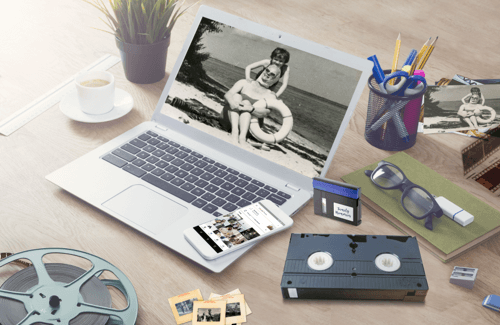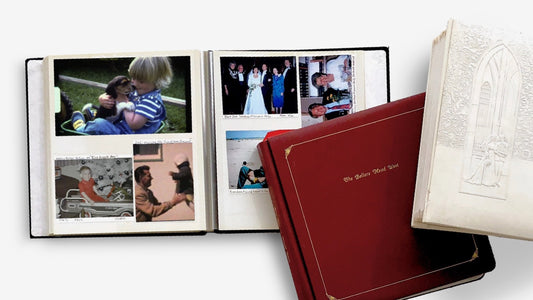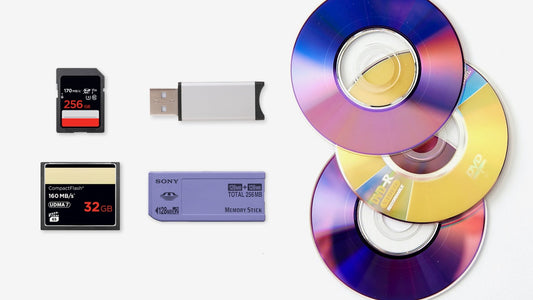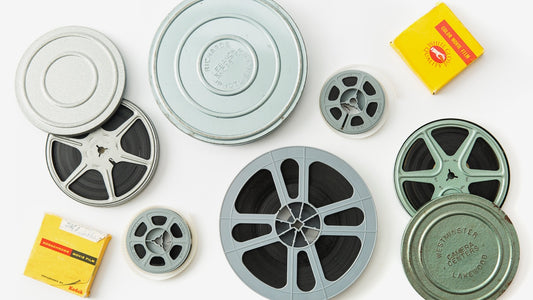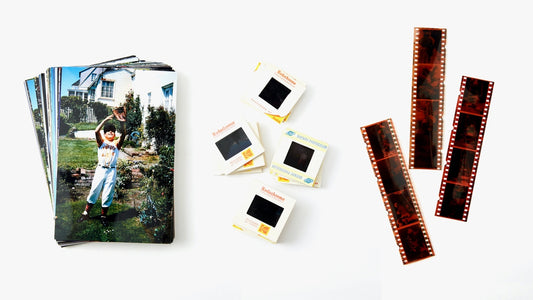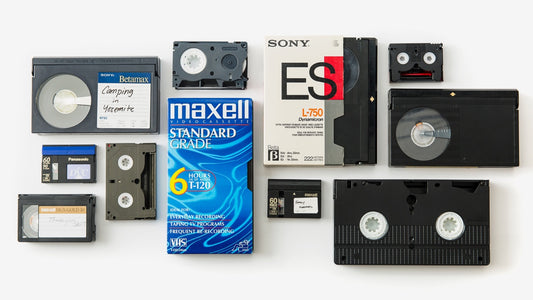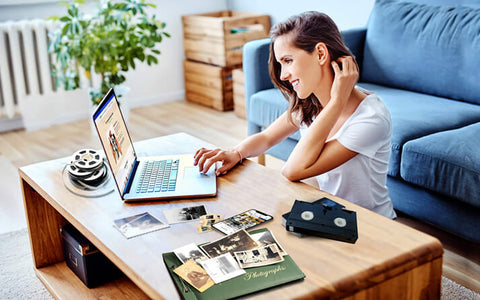That dusty box of 8mm film in your attic holds more than just old reels; it holds your family’s history. You can almost hear the laughter from a childhood birthday or see the smiles from a long-ago vacation. But those precious memories are trapped on a format that’s nearly impossible to watch today. The solution is converting your 8mm film to digital. This is about more than just technology—it’s about reconnecting with your past and sharing it with future generations. This guide will walk you through your choices, helping you find the best way to preserve those irreplaceable moments for good.
Key Takeaways
- Decide if you want convenience or a hands-on project: A professional service is the best choice for high-quality, worry-free results, especially for large collections. The DIY route requires buying a scanner and investing significant time, making it better suited for small projects where you enjoy the technical process.
- Look beyond the price tag when choosing a service: A trustworthy company will be transparent about how they handle your delicate film, their security measures, and their turnaround times. Make sure you understand how you’ll receive your digital files and how long you’ll have access to them online.
- Prepare your films for the best results: A few simple steps can dramatically improve your final videos. Gently clean your reels with an anti-static cloth, label them in the order you want them digitized, and check for any serious damage like mold before sending them in.
How to Convert 8mm Film to Digital
Once you’ve decided to digitize your 8mm films, the next big question is how. You have two main paths: using a professional service or trying a do-it-yourself project. Going pro is the most reliable way to get high-quality results, as these services have the right equipment for fragile film. A DIY approach can save money if you have the time and technical skill. Let’s walk through the options to find the perfect fit.
Choosing a Professional Film Conversion Service
1. YesVideo
As industry leaders, we handle every reel by hand in the USA. Our technicians specialize in fragile film, and our complete film transfer service includes cleaning, color correction, and a private online account for viewing and sharing. It’s a secure, white-glove service for your most precious moments.
2. Walmart Photo Center
For convenience, you can drop your films off at a Walmart Photo Center. They partner with experts (like us at YesVideo) to process the orders, so you can hand off your memories at a trusted local store.
3. CVS Photo
CVS provides a simple drop-off point for your media conversion needs. It’s a great way to start your project without worrying about shipping, and they can handle everything from film reels to old photo albums.
4. Costco Photo Center
A quick note: While Costco was once a popular photo hub, they no longer offer film transfer services. You’ll need to choose another provider for your 8mm reels.
5. Walgreens Photo
Walgreens is another accessible retail option. Just bring your home movies and film to their photo counter, and they’ll send them out for professional processing.
6. Local Photo Shops and Film Labs
For a personal touch, look for local photo labs. An online search can help you find small businesses where you can speak directly with the technician handling your film.
What Else Can Be Digitized? (It's Not Just 8mm Film)
Once you start digging through those boxes in the attic, you’ll likely find more than just 8mm reels. Your family’s collection of memories probably spans decades and includes a mix of different media formats. The good news is that your preservation project doesn’t have to stop with film. Professional services are equipped to handle a wide variety of formats, allowing you to gather your entire family history into one safe, accessible digital library. From the camcorder tapes of the 90s to the photo albums your grandmother assembled, it can all be brought into the present.
Other Film Formats (16mm, Super 8)
Your 8mm film reels might be sharing a box with their close relatives: Super 8 and 16mm film. Super 8 was introduced as an easier-to-use alternative, while 16mm was often used by serious hobbyists for its higher image quality. Each format requires specific equipment and handling to scan correctly. Rather than trying to find separate solutions for each type, a comprehensive film transfer service can process all of them for you. This ensures that every cinematic memory, whether it’s on Regular 8, Super 8, or 16mm film, receives the same professional care and is added to your digital collection.
Videotape Formats (Hi8, Video 8, Digital 8)
As film gave way to video, the family documentarian switched to camcorders. This means you probably have a stack of tapes in formats like VHS, VHS-C, Hi8, Video 8, or MiniDV. These tapes are just as vulnerable to decay as film, and finding a working VCR or camcorder to play them is a challenge in itself. A professional video transfer service is the easiest way to liberate these memories. You can convert everything from Betamax to Digital 8 tapes, making those birthday parties, school plays, and holiday gatherings watchable on any modern device.
Photos, Slides, and Audio Tapes
Your visual history isn’t limited to moving pictures. Think of all the photo prints, 35mm slides, and negatives tucked away in albums and boxes. These are key parts of your family’s story. You can digitize individual photos and slides or even have entire photo albums scanned page by page to preserve the original context and handwritten notes. Some services can even handle audio formats like cassette and reel-to-reel tapes, ensuring that the sound of a loved one’s voice isn’t lost to time. Consolidating all these formats creates a complete, multimedia archive of your family’s legacy.
Going the DIY Route for Film Conversion
Using a Film-to-Digital Converter
These standalone devices scan your film frame by frame onto an SD card. They’re user-friendly, but the quality doesn’t match professional scans. Be prepared for a slow, manual process with these 8mm movie converters.
The Projector and Camera Method
This method involves recording a projection of your film. It’s tricky to get right, as you’ll need to manage flicker, focus, and color. This option requires significant patience and technical skill.
Can You Use a Smartphone App?
Smartphones aren't equipped for 8mm film. The process requires specialized hardware to handle the delicate reels, so it’s best to use a dedicated converter or professional service for your film.
How Much Does It Cost to Digitize 8mm Film?
Figuring out the cost and quality of film conversion can feel a bit like a puzzle, but it’s straightforward once you know what to look for. The final price tag and the clarity of your digitized memories depend on a few key factors, whether you choose a professional service or decide to do it yourself. Understanding these elements will help you set a realistic budget and choose the best path for your precious films.
Key Factors That Affect Price and Quality
The Length and Amount of Your Film
The most significant factor in pricing is the amount of film you have. Most professional services charge by the foot. For example, some services start with a base price for the first 50 or 100 feet and then add a smaller fee for each additional foot. A standard 3-inch reel of 8mm film holds about 50 feet, which runs for about 3 to 4 minutes. If you have a box full of larger 7-inch reels, you’re looking at 400 feet per reel, so the costs can add up. Before you send your film off, it’s a good idea to measure your reels to get a rough estimate of your total footage and cost.
Your Preferred Digital File Format
How you want to receive your newly digitized movies also plays a role in the final cost. The most common options are digital download, USB drive, or DVD. A digital download is often included as a standard option, giving you immediate access to your files through a secure online account. You can then save them to your computer or a cloud service. For a physical copy, you can usually add a USB drive or DVD to your order for an additional fee. While DVDs were once the standard, a USB offers more flexibility for viewing on modern devices like smart TVs and computers.
Resolution and Scanning Technology
This is where quality really comes into play. A common misconception is that all digitization services offer the same results, but the technology they use makes a huge difference. High-quality services use frame-by-frame scanning to capture a crisp, high-definition digital image from each individual frame of your film. This method ensures a stable, flicker-free video. Lower-cost options might project the film and re-record it, which can result in a lower-resolution, less clear final product. When you’re comparing services, look for details about their scanning process to understand the quality you can expect from their film transfer service.
Add-On Services like Color Correction
Over the decades, the color in your film can fade, leaving it with a blue or pink tint. Many professional services offer additional enhancements like manual color correction and lighting adjustments to help restore your footage to its original vibrancy. Some may also include scratch and dust reduction to clean up the image. These services are often part of a premium package but can dramatically improve the viewing experience. If your films are particularly old or faded, investing in these touch-ups can be well worth it.
Your Choice of Output Media (USB, DVD, Cloud)
Once your film is digitized, you’ll need to choose how you want to receive your new video files. Most services offer a few standard choices: a USB drive, DVDs, or a digital download from the cloud. A USB drive is a popular and practical option, giving you a physical copy that you can easily plug into a computer or smart TV. DVDs are a more traditional choice, but they’re becoming less common as many new laptops no longer include a disc drive. The most flexible option is a digital download. With this, you get access to your memories through a private online account, where you can watch, share, and save the files directly to your devices. At YesVideo, we provide every customer with a secure online account to access their memories, plus the option to add a USB or DVDs to their film transfer order, giving you the best of both worlds.
Pro vs. DIY: A Cost and Quality Breakdown
How Professional Services Price Their Work
Professional services typically have a clear pricing structure. For instance, YesVideo charges a flat fee that covers your first batch of media, like the first 100 feet of film. After that, it’s a set price per foot. This model makes it easy to calculate your total cost based on the number of reels you have. The price usually includes the digitization process, a digital copy of your memories in a private online account, and the safe return of your original films. This all-in-one approach takes the guesswork out of the process and ensures your memories are handled by experts.
The Cost of DIY Film Conversion
Going the DIY route might seem cheaper upfront, but the costs can add up. A decent-quality film scanner can cost anywhere from $200 to over $500. While you get to keep the equipment, you also have to factor in the value of your time. Scanning is a slow, manual process that requires patience and a bit of technical know-how. If you have a large collection of films, the hours you spend scanning, editing, and organizing the files can quickly outweigh the money saved. For a small project with just one or two reels, it might be a fun and rewarding experience. For anything more, the convenience and superior quality of a professional service are often the more practical choice.
Pricing by Film Length (Per Foot)
When you work with a professional service, the most common way they calculate cost is by the length of your film, charging a specific price per foot. A small, 3-inch reel typically holds 50 feet of film, while a larger 7-inch reel can contain up to 400 feet. To give you a clear starting point, many services, including YesVideo, offer a package that includes the first set amount of footage, like the first 100 feet. After that, a simple per-foot rate applies. This structure makes it easy to estimate your total cost once you know how many reels you have. It’s a transparent approach that ensures you only pay for the footage you actually need to digitize.
Pricing by Item (Per Reel or Tape)
While less common for film due to varying reel sizes, some services simplify their pricing by charging a flat rate per item. You might see this more often with standardized media like VHS tapes or DVDs. For film, a hybrid model is more typical. For example, a service might charge a base fee per reel to cover the initial handling and setup, and then add a per-foot charge for the actual scanning. This approach combines the predictability of a per-item cost with the fairness of a per-foot rate. It helps manage expectations, as you know exactly what the initial cost will be for each reel you send in, making the entire transfer process feel straightforward and manageable.
Costs for Digital Delivery and Physical Media
After your film is digitized, the final cost factor is how you want to receive your memories. Most services provide a digital download as the standard delivery method, often through a secure online account where you can view, share, and save your files. This is usually included in the base price. If you want a physical copy, you can typically add a USB drive or DVD set to your order for an additional fee. A USB is a great, modern option for easy playback on computers and smart TVs, while DVDs provide a familiar format for gifting to family members. Choosing your preferred digital media gives you the flexibility to enjoy your memories in the way that works best for you.
The Real Cost and Time of a DIY Project
Going the do-it-yourself route might seem cheaper at first, but there are hidden costs to consider. You’ll need to purchase an 8mm film scanner, which can range from around one hundred to several hundred dollars. Beyond the financial cost is the significant time investment. Scanning is a slow, manual process that requires you to feed, monitor, and edit the footage yourself. If you have more than a few reels, be prepared to spend many hours completing the project. It’s a labor of love that requires patience and a bit of technical skill.
Comparing the Quality of Pro vs. DIY Results
Professional services use commercial-grade equipment that is far more advanced than consumer-grade DIY scanners. This results in higher resolution, better color accuracy, and a cleaner final video. While a DIY scanner can get the job done, the quality may not compare, and you might notice issues like flickering or soft focus. If your primary goal is to achieve the best possible quality to preserve your family’s legacy, a professional service that can handle everything from photo transfer to film digitization is almost always the better choice.
Choosing the Right Method for Your Films
Deciding between a professional service and a do-it-yourself project is the biggest choice you’ll make in this process. There’s no single right answer—it all comes down to your budget, your technical comfort level, and how much time you have. Think about what matters most to you. Are you looking for the highest possible quality and peace of mind, or are you a hands-on person who enjoys a technical challenge?
Your precious films deserve the best treatment, whether that’s in the hands of a trained expert or your own. Let’s walk through the key factors for each path so you can feel confident in your decision. We’ll cover what to look for in a professional service and what to honestly ask yourself before starting a DIY project. This will help you weigh the pros and cons and choose the method that fits your life and preserves your memories beautifully.
What to Look for in a Professional Service
Handing over your family’s one-of-a-kind films can feel nerve-wracking, so finding a trustworthy service is essential. When you start comparing companies, look beyond the price tag. You’re not just buying a digital file; you’re entrusting a company with irreplaceable memories. A great service will be transparent about its process, security, and how it handles your originals with care. Dig into the details to find a partner you can rely on to protect and preserve your family’s history for generations to come.
Turnaround Time and Communication
When you send your films away, you’ll want to know where they are and when to expect them back. Look for a service that provides a clear timeline, which can range from a few weeks to over a month depending on the company. Many services offer online order tracking so you can follow your films’ journey. Good communication is key—a company should be easy to reach if you have questions. This transparency provides peace of mind while you wait for your digitized memories.
How They Handle and Care for Your Film
How a company handles your film is one of the most important factors. Your reels are delicate and can be damaged by improper handling or old equipment. Ask if the technicians process films by hand. At YesVideo, for example, every order is processed by our trained technicians in the USA. This hands-on approach ensures each reel is treated with the respect it deserves, preventing the kind of damage that automated, high-volume machines can cause.
Film Cleaning and Repair Options
Over time, film reels collect dust and can become brittle. That’s why cleaning and minor repairs are a crucial first step before scanning. A professional service will gently clean your film by hand to remove any debris that could show up as specks or blotches on your digital video. Some, like Pro8mm, also add new leader tape to the start of the reel to ensure a smooth feed into their scanners. This preparation is vital for getting the clearest possible picture. At YesVideo, our film transfer process always includes careful hand-cleaning and inspection to make sure your memories are ready for their digital debut, ensuring they look their best.
Company Experience and Reputation
When choosing a service, experience is everything. You’re trusting a company with your family’s legacy, so you want a team that has seen it all. Look for businesses with a long, proven track record. For example, Kodak has been a leader in film since 1888, and Legacybox has served over a million customers. This kind of history shows they have the expertise to handle delicate, aging media. With over 20 years of experience, we at YesVideo have become the world’s largest and most trusted digitization service by handling every order with the care it deserves. Reading customer reviews and testimonials will also give you a clear sense of a company’s reputation and commitment to quality.
Online Viewing and Sharing Options
Once your film is digitized, how will you access it? Most services provide an online gallery where you can view, download, and share your videos. Check the details here—some platforms only store your files for a limited time, like 60 or 90 days. Look for a service that gives you flexible and lasting access. The ability to easily save your videos to your own computer or a service like Google Photos is a must for long-term preservation of your new digital media.
Security for Your Original Film Reels
You need to know your original films are safe from the moment they leave your hands. Reputable companies take security seriously. Look for services that describe their security measures, which often include video surveillance of their facilities and unique tracking codes for every order. This ensures your memories are monitored and accounted for throughout the entire digitization process, from arrival to their safe return home.
What Guarantees Do They Offer?
What happens if you’re not happy with the results, or if something goes wrong? Before committing, check the company’s satisfaction guarantee or warranty policy. A trustworthy service will stand by its work and have a clear process for addressing any issues. This guarantee is a sign of the company’s confidence in its quality and its commitment to you as a customer. It’s an extra layer of assurance that your investment is protected.
Digital File Backup and Storage Policies
The work isn’t quite done once your films are digitized—now it’s time to secure your new digital files. Pay close attention to the company’s storage policy, because it can vary quite a bit. Most services offer free cloud access for a limited time, usually 30 to 90 days, before the files might be deleted. It’s best to think of the online gallery as a temporary delivery spot, not a permanent home for your memories. Make it a priority to download everything to your computer and an external hard drive as soon as you get access. For an extra layer of security, you can also order a physical copy on a USB drive. This gives you an immediate backup of your new digital keepsakes and makes sharing with family simple.
Is DIY Right for You?
The do-it-yourself route can be a rewarding project, but it’s important to go in with your eyes open. It requires a specific skill set, a fair bit of equipment, and a significant time investment. Before you buy a scanner or start clearing a space on your desk, take a moment to honestly assess if this path is the right fit for you and your collection. This isn’t just about saving money; it’s about achieving a result you’ll be happy with without getting overwhelmed by the process.
Do You Have the Right Equipment and Skills?
Digitizing film at home requires more than just a smartphone. You’ll need to buy or rent a dedicated film-to-digital converter, which can cost several hundred dollars. These devices require setup, calibration, and some technical know-how to operate correctly. If you’re not comfortable troubleshooting software or handling delicate film, the process can quickly become frustrating. For those who prefer to avoid the technical hassle, a professional film transfer service is a much simpler path.
Considering the Time and Learning Curve
Don’t underestimate the time it takes to digitize film. The conversion happens in real-time, meaning a three-minute reel takes at least three minutes to scan—and that doesn’t include setup, cleaning the film, editing, or organizing the final files. There’s a learning curve to getting the colors and focus right. If you have more than a few reels, this can easily turn into a project that spans weeks or even months.
Is DIY Practical for a Large Film Collection?
If you’ve inherited a large box of family films, a DIY approach might seem cost-effective at first glance. However, the sheer volume can make the project impractical. Managing dozens of reels, ensuring consistent quality, and dedicating hours upon hours to scanning can be a monumental task. For large collections, a professional service is often the more realistic choice, saving you time and guaranteeing a high-quality, uniform result for your entire family archive.
Ready to Convert? Here's What to Do Next
Once you’ve explored your options for converting your 8mm film, you’re on the home stretch. Now it’s time to get your films in order and make a final call. This part of the process is all about setting your project up for success. A little prep work goes a long way in ensuring your digitized memories look their absolute best, and taking a moment to think through your personal needs will help you choose a path you feel great about.
Think of this as the final, thoughtful step before you get to relive those precious moments. Preparing your films isn't just a technical task; it's an act of care for the memories they hold. By cleaning and organizing them, you're ensuring that the laughter, milestones, and everyday moments captured on those reels are preserved with clarity. Similarly, making a final decision isn't just about picking a service or a method. It's about matching your goals—whether they relate to quality, budget, or your own time—with the right solution. This ensures the entire experience is smooth and rewarding, leaving you with beautiful digital keepsakes you can easily share and enjoy for years to come. Let's walk through how to get everything ready.
How to Prep Your Films for Conversion
Taking a few moments to prepare your film reels can make a huge difference in the quality of your final digital videos.
Step 1: Clean and Inspect Your Film Reels
Before sending your films, give them a gentle inspection for dust or grime. A soft, anti-static cloth works well for cleaning reels. This simple step helps ensure the clearest possible picture during the film transfer process.
Step 2: Organize and Label Everything
If you have multiple reels, organizing them by year or event will make everything easier. Label each reel with a number or short description so your digital files are returned in a logical order, ready to enjoy.
Step 3: Check for Damage or Mold
During inspection, look for serious issues like warped film or mold. Mold can permanently damage film, so isolate any affected reels to prevent it from spreading. Addressing damage beforehand is crucial for a successful transfer.
Making Your Final Choice
With your films prepped, you’re ready to decide how to bring them into the digital age. The right choice is the one that works best for you and your family.
Weighing Your Budget, Time, and Quality Needs
Consider your specific situation. How many reels do you have, what quality do you want, and what’s your budget and timeline? If you have many reels and little time, a professional service is practical. If you have a few reels and enjoy a project, DIY could be a fit.
Picking the Right Service or DIY Method
Based on your needs, you can confidently choose your path. For those who prioritize quality and convenience, a professional service is ideal. If you’re more hands-on, DIY can be rewarding. There’s no single right answer, only what’s right for you.
Planning for File Formats and Storage
Finally, plan for your new digital files. Understand the formats offered, like MP4, and how you’ll receive them. It’s smart to back up your memories in multiple places, like the cloud and a hard drive, to keep them safe. This is a key part of managing your new digital media.
Related Articles
- Convert 8mm to Digital: The Ultimate Guide (2023) – YesVideo
- Convert 8mm Film to Digital: DIY & Pro Guide – YesVideo
- 8mm to DVD: Top Conversion Services & DIY Guide – YesVideo
- 8mm Film Converter: Your Smart Buying Guide – YesVideo
- Film Transfer – YesVideo
Frequently Asked Questions
What if my films are really old or have some damage? Can they still be saved? This is a very common worry. The good news is that old film is often more resilient than you might think. Professional services are equipped to handle brittle or faded film and often include cleaning as part of the process, which can remove decades of dust. If you notice significant damage like mold or broken splices, it's best to let the experts handle it. They have the tools and experience to repair minor issues and get the best possible image from even very old reels.
How long will it take to get my digitized movies back? The turnaround time really depends on the service you choose and how busy they are. Generally, you can expect the process to take anywhere from a few weeks to a little over a month. Reputable companies will give you a clear timeline upfront and often provide an online tracking system so you can see where your order is in the process. It’s a little bit of a wait, but knowing your memories are being handled carefully makes it worthwhile.
Is the quality from a professional service really that much better than a DIY scanner? Yes, the difference is usually quite noticeable. Professional services use commercial-grade equipment that scans each frame of your film individually, resulting in a stable, high-definition video with accurate colors. Home scanners are great for a hobbyist, but they often produce a softer image and can struggle with flicker or color balance. If your goal is to create a lasting family archive with the best possible clarity, investing in a professional transfer is the way to go.
I found 8mm films, but I also have a box of old VHS tapes and photo albums. Can I get everything digitized at the same time? Absolutely. Many services, including YesVideo, are set up to handle a wide variety of media formats. You can typically send in your films, videotapes, photos, and even entire photo albums in a single order. This simplifies the process immensely, as you only have to pack one box and work with one company to preserve all your different types of memories. It’s a convenient way to tackle your entire family archive at once.
What happens to my original 8mm reels after they are converted? Your original films are irreplaceable, and any trustworthy company understands that. After the digitization process is complete, a professional service will carefully package and return all of your original reels to you along with your new digital copies. You never have to choose between the original and the digital version; you get to keep both.





